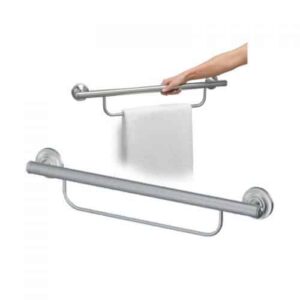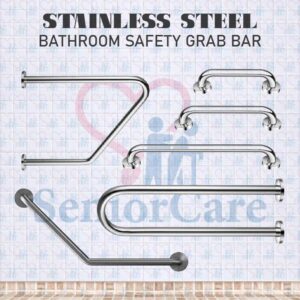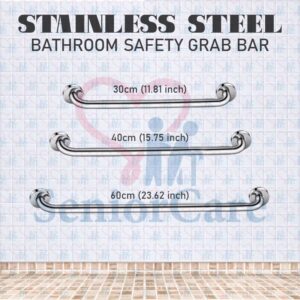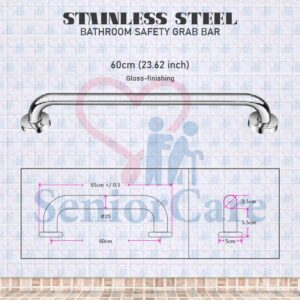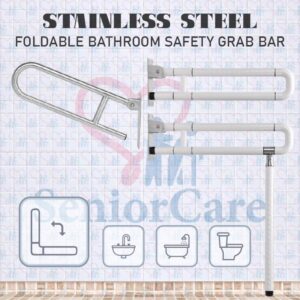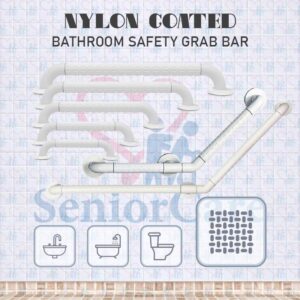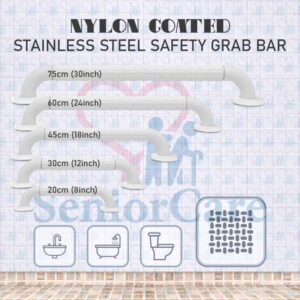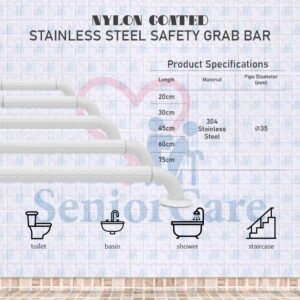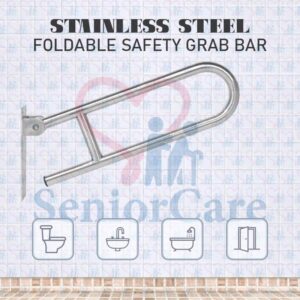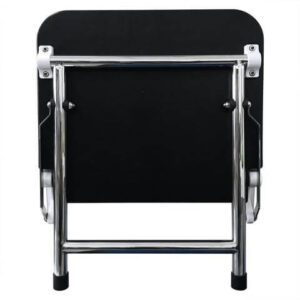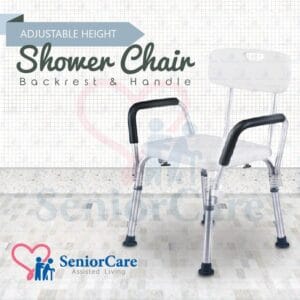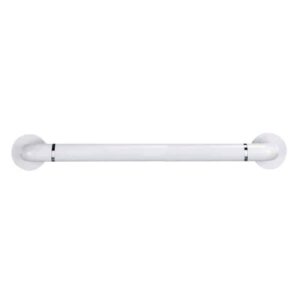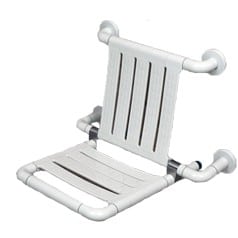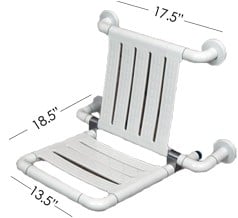What type of Safety Grab Bars for the toilet / shower / bathroom should you install?
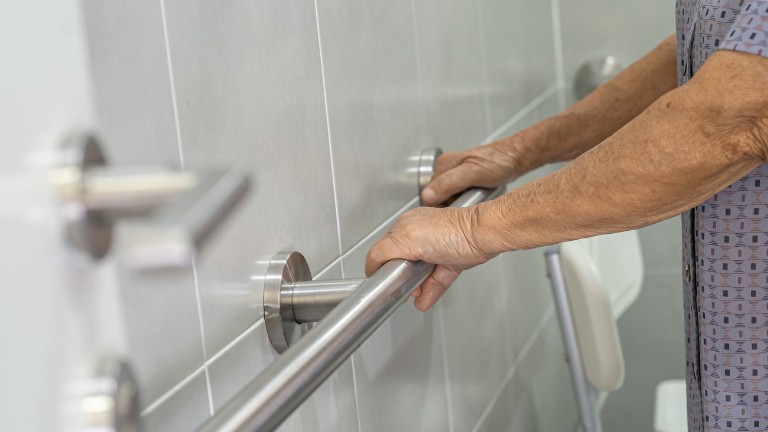
There are several types of grab bars available, each designed to serve specific purposes and cater to different needs.
Here are some common types of grab bars:
- Wall-mounted grab bars: These are the most common type of grab bars and are permanently installed on the wall. They are typically made of metal (such as stainless steel) or plastic, and they come in various lengths and diameters. Wall-mounted grab bars provide stability and support in areas like bathrooms, showers, and next to toilets.
- Suction cup grab bars: These grab bars use suction cups to attach to smooth, non-porous surfaces temporarily. They can be easily installed and removed without the need for drilling or permanent mounting. Suction cup grab bars are portable and often used for travel or temporary installations, but they are generally not as secure or reliable as wall-mounted grab bars.
- Floor-to-ceiling grab bars: Also known as pole or tension-mounted grab bars, these bars extend from the floor to the ceiling and provide vertical support. They are ideal for individuals who require stability when moving from a seated to a standing position, such as in the bedroom or near chairs and couches.
- Flip-up grab bars: These grab bars are hinged and can be flipped up and out of the way when not in use. They are commonly used in bathrooms and near toilets, allowing for convenient access while also providing support when needed.
- Bathtub grab bars: Specifically designed for use in bathtubs, these grab bars often have a curved or contoured shape to fit the edge of the tub. They can assist with getting in and out of the bathtub safely.
- Specialty grab bars: There are also grab bars that serve specific purposes or cater to unique needs. For example, there are grab bars with integrated towel racks or toilet paper holders, which provide both functionality and support. Additionally, there are angled or offset grab bars that are designed to accommodate individuals with limited mobility or space constraints.
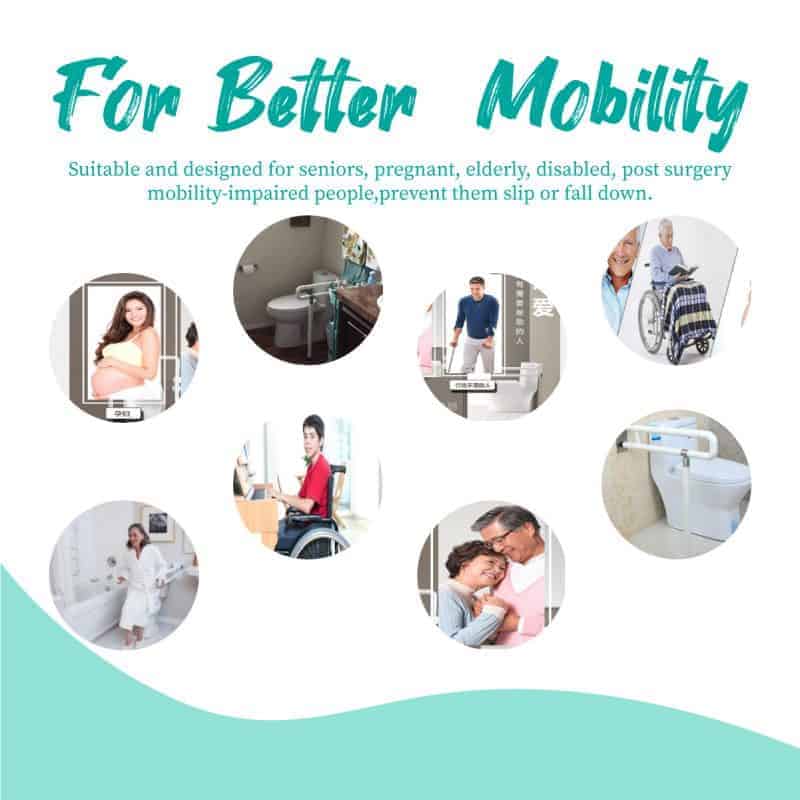
When selecting grab bars, it’s important to consider factors such as weight capacity, durability, and proper installation to ensure their effectiveness and safety.
Consulting with a professional, such as an occupational therapist or a contractor experienced in accessibility modifications, can help you choose the appropriate type and placement of grab bars based on your specific requirements.
Are suction grab bars for the bathroom safe?
Suction grab bars for the bathroom can provide some level of assistance and support, but their safety and effectiveness depend on several factors.
Suction grab bars are typically designed to be temporary and can be easily attached to smooth, non-porous surfaces like tiles, glass, or acrylic. They create suction when pressure is applied to them, creating a secure attachment. However, it’s important to note that suction grab bars are not as secure or reliable as permanently installed grab bars, which are mounted directly onto wall studs or using specialized hardware.
While suction grab bars can be convenient for some individuals, there are a few considerations regarding their safety:
- Surface compatibility: Suction grab bars require a smooth, non-porous surface for optimal performance. If the surface is textured, porous, or uneven, the suction may not hold securely, leading to the risk of the bar coming loose and causing accidents.
- Proper installation: It’s crucial to follow the manufacturer’s instructions carefully when installing suction grab bars. This includes ensuring the surface is clean, dry, and free from any debris or residue that could affect the suction. Regular maintenance and inspection of the bars are also essential to check for any signs of wear or loss of suction.
- Weight-bearing capacity: Suction grab bars have weight limits specified by the manufacturer. It’s important to ensure that the grab bar is suitable for the intended user’s weight to maintain stability and prevent accidents.
- Individual strength and stability: Suction grab bars require the user to have sufficient upper body strength to support their weight and stabilize themselves. If someone has limited upper body strength or balance issues, they may not be able to rely solely on a suction grab bar for support and may need additional assistance.
In summary, suction grab bars can offer some assistance in the bathroom, but they should not be considered a permanent or sole solution for individuals who require significant support.
Where should grab bars be placed in the shower?
Grab bars in the shower should be strategically placed to provide support and stability. Here are some general guidelines for their placement:
- Entry and exit points: Install a grab bar near the entry and exit points of the shower. This helps individuals maintain balance while entering or exiting the shower and reduces the risk of slipping or falling.
- Vertical grab bar: Place a vertical grab bar on the shower wall, typically on the back wall or the wall opposite the showerhead. This provides support for individuals who need assistance standing or maintaining balance while showering.
- Horizontal grab bars: Horizontal grab bars can be beneficial for individuals who prefer to sit while showering or need support at different heights. Consider placing one horizontally along the side wall of the shower, within reach of a seated position.
- Combination grab bars: Some grab bars are designed with a combination of vertical and horizontal sections. These versatile bars can be installed at an angle to provide support for different needs, such as transitioning from a seated to a standing position.
- Reinforced walls: When installing grab bars, it’s important to ensure they are securely mounted to reinforced walls. This typically involves attaching the grab bars to wall studs or using appropriate mounting hardware to ensure stability and weight-bearing capacity.
It’s worth noting that the specific placement of grab bars may vary depending on individual needs, physical abilities, and the layout of the shower.
Where should grab bars be placed by the toilet?
Grab bars near the toilet can provide support and assistance for individuals when sitting down, standing up, or maintaining balance. Here are some common recommendations for the placement of grab bars by the toilet:
- Vertical bar next to the toilet: Install a vertical grab bar on the wall next to the toilet, typically on the side closest to the user’s dominant hand. This bar should be within easy reach and should extend from about 33 to 36 inches (84 to 91 centimeters) above the floor. It should be securely mounted to the wall, preferably to a reinforced wall stud or using appropriate mounting hardware.
- Horizontal bar behind the toilet: Consider installing a horizontal grab bar behind the toilet, parallel to the floor. This bar should be positioned at a height of approximately 33 to 36 inches (84 to 91 centimeters) above the floor. It should be long enough to provide support on both sides of the toilet and securely mounted to the wall.
- Combination grab bars: Some grab bars are designed with a combination of vertical and horizontal sections. These bars can be installed at an angle, offering support for different movements, such as sitting down or standing up from the toilet. The angled section can be positioned to provide optimal assistance based on individual needs and preferences.

Remember, it’s essential to ensure that the grab bars are properly installed and securely mounted to provide stability and support. If you’re unsure about the installation process or the appropriate placement for your specific needs, it’s recommended to consult with a professional.
Should grab bars be vertical or horizontal?
Grab bars can be installed in both vertical and horizontal orientations, depending on the specific needs and preferences of the individual using them. Both orientations can provide support and stability, but their effectiveness may vary depending on the situation and the user’s requirements. Here are some considerations for vertical and horizontal grab bars:
Vertical Grab Bars:
- Vertical grab bars are commonly installed next to toilets and in shower areas.
- They can assist with sitting down, standing up, and maintaining balance.
- Vertical bars are beneficial for individuals who need support while transitioning from a seated to a standing position or vice versa.
- They are also useful for individuals who may need to stabilize themselves during transfers or movements.
Horizontal Grab Bars:
- Horizontal grab bars are often installed behind toilets or along walls in showers.
- They can provide support for individuals while sitting on the toilet or moving within the shower area.
- Horizontal bars can be useful for individuals who prefer to use their arms to lower or raise themselves from a seated position.
- They can also assist individuals who require stability while maneuvering in the shower.
In some cases, combination grab bars that include both vertical and horizontal sections are available. These versatile bars can be installed at an angle to provide support for different movements and preferences.
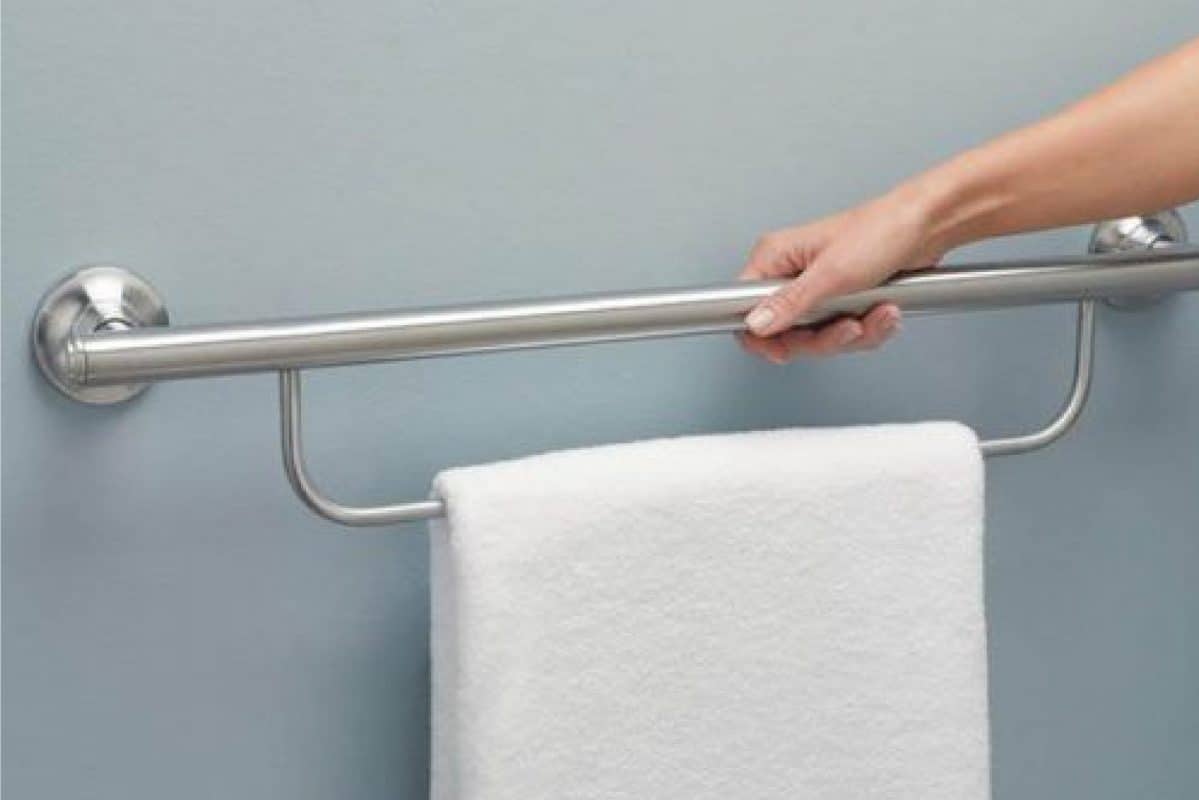
Ultimately, the choice between vertical and horizontal grab bars depends on the individual’s needs, physical abilities, and personal preferences.
What is the ideal bathtub grab bars placement?
When installing grab bars in a bathtub, their placement should be carefully considered to ensure they provide optimal support and safety. Here are some general guidelines for bathtub grab bar placement:
- Vertical grab bar near the entry/exit point: Install a vertical grab bar on the wall near the entry or exit point of the bathtub. This bar should be positioned to assist with entering or exiting the tub, providing stability during those movements.
- Horizontal grab bar along the back wall: Place a horizontal grab bar along the back wall of the bathtub. This bar should be installed at a height that allows the user to reach and hold onto it comfortably while sitting in the bathtub. It should run parallel to the floor and provide support for individuals while bathing or transitioning from a seated to a standing position.
- Additional grab bars based on individual needs: Depending on the user’s specific needs, additional grab bars can be installed. For example, if the individual requires assistance when transferring from a seated position to the floor of the tub, a horizontal grab bar along the side wall might be beneficial. It’s important to evaluate the individual’s abilities and consult with a professional to determine the most appropriate placement of additional grab bars.
- Consider the edge of the tub: Ensure that the grab bars are positioned in a way that allows for easy and safe access to the tub. They should be installed at a height that accommodates the user’s reach and provides a comfortable grip.
- Wall reinforcement: When installing grab bars, it’s crucial to mount them securely to reinforced walls. This typically involves attaching the grab bars to wall studs or using appropriate mounting hardware to ensure stability and weight-bearing capacity.
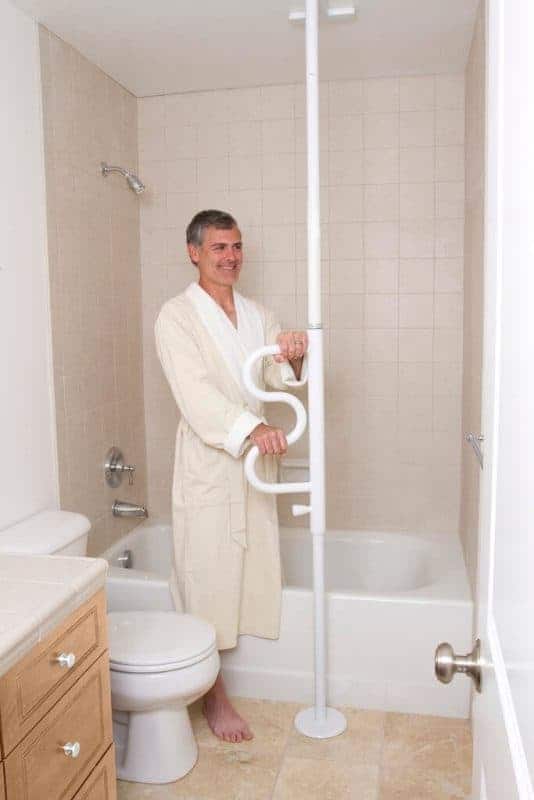
Remember, the specific placement of grab bars may vary depending on individual needs, physical abilities, and the layout of the bathtub.
What are some modern shower grab bars?
Modern shower grab bars offer both functionality and aesthetics, incorporating sleek designs and innovative features. Here are some examples of modern shower grab bars:
- Decorative grab bars: These grab bars blend functionality with style by featuring decorative elements and finishes. They can resemble towel bars or other bathroom fixtures, adding a touch of elegance to the shower area while providing reliable support.
- Ergonomic grab bars: Designed with ergonomics in mind, these grab bars offer a comfortable and secure grip. They often have contoured shapes or textured surfaces that enhance grip and minimize the risk of slipping, even when wet.
- LED-lit grab bars: Some modern grab bars are equipped with LED lights, which can illuminate the shower area. These bars provide both support and ambient lighting, enhancing visibility and safety in the shower.
- Telescoping grab bars: Telescoping grab bars are adjustable in length, allowing users to customize their positioning based on their needs. They can be extended or retracted as necessary, providing flexibility in terms of placement and support.
- Multi-function grab bars: These grab bars incorporate additional features or accessories to enhance functionality. They may include built-in shelves, soap dishes, or hooks for hanging towels or shower accessories, optimizing space utilization and convenience.
- Foldable grab bars: Foldable grab bars can be folded up against the wall when not in use, providing a streamlined look and maximizing space in the shower area. They can be easily pulled down and locked into position when support is needed.
- Non-metallic grab bars: Traditional grab bars are often made of metal, but modern alternatives include non-metallic materials such as durable plastics or composite materials. These options can be corrosion-resistant, lightweight, and easier to clean and maintain.
When choosing modern shower grab bars, it’s important to ensure they meet safety standards and have appropriate weight-bearing capacity. Additionally, consider the specific needs and preferences of the users to select grab bars that provide adequate support and comfort.
Where can I buy grab bars for the showers, toilets, bathroom in Singapore?
You can ask your renovation contractor or interior designer.
If you like a simple handyman job or just want to add on to your existing home, you can just buy wider range of grab bars for toilet bathroom online with free delivery and then get a handyman to install them for you at your home.

